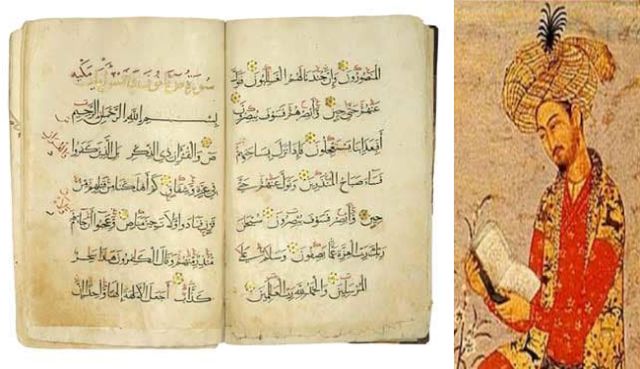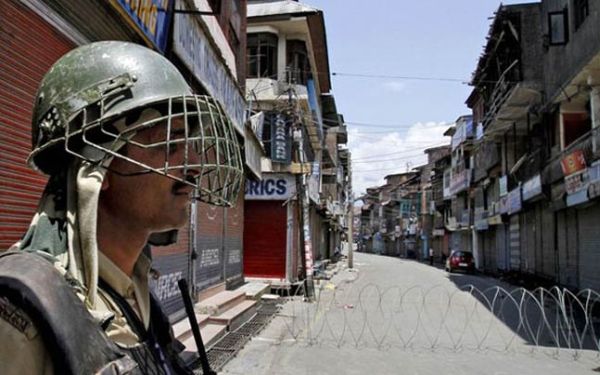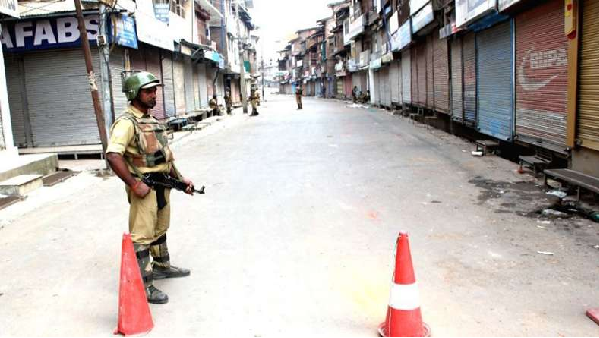
by admin | May 25, 2021 | News
 Srinagar : Clashes broke out in Anantnag on Wednesday after reports of a Ph.D scholar being killed in a shootout even as the authorities continued to face separatist protests against Sunday’s civilian deaths in Kulgam for the second consecutive day.
Srinagar : Clashes broke out in Anantnag on Wednesday after reports of a Ph.D scholar being killed in a shootout even as the authorities continued to face separatist protests against Sunday’s civilian deaths in Kulgam for the second consecutive day.
Sabzar Sofi, the Ph.D scholar, was killed along with his associate Asif Ahmed in Nowgam earlier in the day.
Skirmishes broke out immediately in the city outskirts as stone pelting youths attacked the security forces forcing schools and colleges to shut down in the Srinagar district.
In New Delhi, Jamia Milia Islamia refuted news reports that Sabzar Sofi had ever registered as a student with the university. It also said that there was no Botany department in the university as was reported by the media.
Clashes also broke out in Sangam area of Anantnag district where Sofi is from. People were outraged at the killing of the militant who was seen preparing for the civil service exams before joining militancy in October 2016.
People in Kulgam town saw heavy deployment of security personnel as the authorities continued restrictions in the Jammu and Kashmir town to prevent separatist-called protest march against seven civilian deaths in an explosion on Sunday.
All roads leading to Kulgam town were sealed. The march was called by the Joint Resistance Leadership on Tuesday in solidarity with the families of the seven killed in an explosion at the gunfight site in Laroo village.
Senior separatist leaders Syed Ali Geelani and Mirwaiz Umer Farooq have been under house arrest since Monday while Yasin Malik was taken into preventive custody.
—IANS

by admin | May 25, 2021 | Books
 By Mayabhushan Nagvenkar,
By Mayabhushan Nagvenkar,
Book: Empress: The Astonishing Reign of Nur Jahan; Author: Ruby Lal; Publisher: Penguin-Viking; Pages: 308; Price: Rs 599
For certain generations of Indians, the cinematic fable of Anarkali is perhaps the most celebrated, but cliched, introduction to royal court intrigues of the Mughal era, in which an enraged Emperor Akbar orders the confinement of Shehzada Salim or Jehangir’s lover and semi-fictional heroine in a nondescript portion of a wall at the Lahore fort, following an elaborate courtship, including song and dance.
Ruby Lal’s biography “Empress: The Astonishing Reign of Nur Jahan” in many ways tries to throw the spotlight on the real heroine of the life and times of Jehangir: His empress Nur Jahan.
Lal, in her feminist biography of the Nur Jahan — born Mihr un-Nisa — underscores her worth in the otherwise overwhelmingly male-dominated annals of the Mughal empire, which have invariably spoken about the men who wore the crown and defined the destinies of the millions who lived in their empire.
Nur Jahan, according to Lal, was everything every Mughal empress, before and after her, wasn’t.
A warrior who led troops into battle, an expert horse-rider, a widow who ended up marrying an emperor, an empress who issued royal proclamations and who had royal coins with her name etched on them. And when push came to shove, also rescued Jehangir after he was imprisoned by one of his officers.
Lal’s approach in chronicling Nur Jahan is an interesting one. By using historical fact as an easel, the author paints rich, vivid, descriptive strokes of Nur Jahan’s journey from the daughter of a relatively nondescript and persecuted Persian nobleman, their perilous travels to the Mughal court in Lahore and her dramatic rise to becoming the Empress of the mighty Mughal Empire.
“Asmat and Ghiyas would have walked along the streets crowded with houses, perhaps exploring the bazaars, that pulsates with energy, packed with buyers and sellers, and passersby exchanging greetings and the news. One section of the bazaar, a series of intricate lanes, was set aside for women only. Women took their time gazing at the bold patterns and colourful embroidery on the finest muslins, silks and velvets. Many wore flowers in their hair, and toe rings and anklets with charms or little bells and chewed betel leaf to redden their lips. Married women wore maang, red colour in the parting of their hair; or the sekra, seven or more strings of pearls that hung from a band at the forehead or the laung, a clove-shaped stud ornamenting the nose” is how Lal evocatively describes the scenes which Nur Jahan’s parents would have encountered in 16th century Lahore, a flourishing centre of trade and a beacon for the persecuted Persian parents, whose daughter in the decades to follow would be the Empress of the Empire.
The book also puts into context different narratives about the rise of Nur Jahan, while laying down antecedents of the chroniclers of the time, thus allowing the reader to gauge and understand the political and historical context to the narrative.
For example, while summarising three parallel narratives about a snake threatening a just-born Mihr un-Nisa, she says: “An Italian quack doctor, an Indian courtier, a Scottish adventurer — each wrote of Nur Jahan’s birth. The Catholic mercenary Manucci (Italian) was interested in an imitation of Christ. For Khafi (courtier), the Indo-Persian tales of migration and a man’s compassion for his wife were dominant. Alexander Dow (Scotsman) and the early colonial writers who followed him were enchanted by a romantic image of India, that land of wonders, surprises — and snake charmers.”
“Empress: The Astonishing Reign of Nur Jahan” is a rare lyrical read about a dashing woman who not only smashed the prevailing high walls of conservatism of her time, but whose influence is also unfortunately overshadowed in India by the romance of a Jehangir’s semi-fictional lover, Anarkali.
(Mayabhushan Nagvenkar can be contacted at mayabhusha.n@ians.in )
—IANS

by admin | May 25, 2021 | News
 London : Collectors and connoisseurs of Islamic and Indian art are in for a treat as medieval historical artefacts dating between the 9th and the 19th centuries will be on auction at Christie’s London on Thursday.
London : Collectors and connoisseurs of Islamic and Indian art are in for a treat as medieval historical artefacts dating between the 9th and the 19th centuries will be on auction at Christie’s London on Thursday.
Illustrations from an early “Baburnama”, gilded manuscripts of the Quran, a 17th century painting of Hindu goddess Bagalamukhi, and a pigment-on-paper work showing Mughal emp`eror Jahangir on a lion-hunt, will be some of the works that will go under the hammer at the day-long auction titled “Art of the Islamic and Indian Worlds”.
Many cover a geographical area stretching from India in the east to Al-Andalus in modern Spain in the west, Christie’s said in a statement.
On offer will be an illustration by artist Haydar Kashmiri from an early “Baburnama” — an autobiographical account of Babur (1483-1530), who founded the Mughal empire in the Indian subcontinent in 1526.
The illustration shows a battlefield, but interpreters are divided about which war it depicts, with many pointing to the Battle of Kandahar, Christie’s said.
Another striking work on sale would be a painting of the Hindu goddess Bagalamukhi, dating back to 1630s, attributed to Mughal court artist Payag.
This painting of the deity, believed to be among the 10 avatars of Devi that runs parallel to those of Hindu god Vishnu, holds importance as its provenance relates to Mughal patronage.
The auction focussing on Islamic art also showcases gold illuminated manuscripts of the Quran, with carefully preserved parchments also holding some of the earliest forms of calligraphy.
Also on offer are many iconographical paintings relating to Islamic and Indian mythology and court life, including one where the fourth Mughal emperor Jahangir is seen brandishing his sword in front of a lion in a jungle hunt.
The auction, housing many more artefacts, is preceded by an exhibition at Christie’s London, that started on Saturday.
—IANS

by admin | May 25, 2021 | Opinions
 By Amulya Ganguli,
By Amulya Ganguli,
There was never any doubt about the Bharatiya Janata Party’s (BJP) anti-minority electoral gambits but the agenda has now been unambigiously and forcefully articulated by the party’s friend, philosopher and guide, the Rashtriya Swayamsevak Sangh (RSS).
Delivering the organisation’s customary message on the occasion of Dussehra/Vijay Dashami, its chief, Mohan Bhagwat, has left no stone unturned about what the Narendra Modi government should immediately do — which is to start building the Ram temple in Ayodhya even by enacting an ordinance.
By pointedly ignoring the fact that the issue is currently before the Supreme Court, the RSS chief has taken the party and the Hindutva brotherhood to the days of the Ramjanmabhoomi movement in the 1990s when the saffron storm-troopers used to say that the courts can have no say in a matter of faith.
Apart from a reiteration of this aggressive “religious” stance, Bhagwat’s directive to the BJP to get down to business and not dilly-dally any longer on building the temple has scrapped Atal Behari Vajpayee’s decision in 1996 to put in cold storage the three “core” issues of the Sangh parivar — building the temple, doing away with Article 370 of the Constitution conferring special status on Jammu and Kashmir, and introducing a uniform civil code
That the negation of Vajpayee’s wishes has been done in the year of his death is not without significance. It remains to be seen whether the RSS will give any “advice” to the government on the two other issues — Article 370 and the uniform civil code.
But why the sudden hurry about constructing the temple? There may be two reasons. One is that it is the last throw of the dice by the party and the parivar in an election season to consolidate its vote bank of communal-minded Hindus at a time when the less than favourable economic scene may make sections of the liberal Hindus, who voted for the BJP in 2014, drift away.
The other is the realisation in the saffron brotherhood that it is now or never where the temple is concerned since the BJP is unlikely to get a majority on its own in the Lok Sabha in 2019. The National Democratic Alliance (NDA) led by it may get it, but it will not be easy for the BJP to persuade some of its allies such as the Janata Dal (United) — which has opposed the BJP’s favourite triple talaq ordinance — and the Akali Dal to endorse a construction programme which cannot but alienate the minorities.
Notwithstanding BJP president Amit Shah’s conviction that the party will reign for half a century, there may be an awareness in the organisation that the 2014 outcome was the result of several unforeseen events — the Congress’s sudden and somewhat inexplicable collapse and Modi’s emergence (against the wishes of several in his party) as some kind of a messiah. From this standpoint, 2019 will not be the same as 2014.
Ever since the party and the parivar sensed that the mantras of neither “achhe din” (good days) nor “sabka saath, sabka vikas” (development for all) is evoking a favourable response, the focus of the saffron propaganda has been on Hindu-Muslim polarisation.
Whether it is extending the scope of the National Register of Citizens (NRC) from Assam to other states or the removal of long-established Muslim names in Uttar Pradesh like Mughalsarai and Allahabad, the BJP’s aim has been to send the message that Muslims will be under pressure to prove the genuiness of their citizenship and that India’s multi-cultural past will be erased as Hindu rashtra takes root.
Along with the direct and indirect offensive against Muslims, the parivar is also intent on confirming its Hindu credentials by opposing the Supreme Court’s verdict allowing women of all ages to enter the Sabarimala temple in Kerala on the grounds it violates centuries-old beliefs.
The Sabarimala episode enables the RSS and the BJP to try and kill two birds with one stone. One is to project themselves as the standard-bearers of Hinduism, and the other is to flaunt a defiance of the Supreme Court.
The court has aroused the saffron lobby’s ire ever since it delivered a series of “progressive” judgments (of which Sabarimala is one) such as the one upholding the rights of privacy, which the government argued was an elitist concept, and the other was to decriminalise homosexuality in a case from which the government recused itself evidently because while the legalisation went against the BJP’s crusty orthodoxy, the party could not afford to be seen as living in Victorian times.
Sabarimala has given an opportunity to the RSS and the BJP to defy the apex court and suggest that it is not right all the time. The defiance may have also been motivated by the #MeToo movement which has claimed the scalp of a Union minister and persuaded another minister to say that those who support the movement are “perverted”.
Among the others who also answer to the description of being perverted are the so-called “Urban Naxalites”, a new form of abuse coined by the RSS and the BJP for the Left-Liberals who have always been called anti-nationals. Not surprisingly, another of the RSS chief’s advice to the government was to keep the “Urban Naxalites” under surveillance.
It will be interesting to know what those “secularists” who interacted with the RSS recently like former President Pranab Mukherjee and the business tycoon, Ratan Tata, think of the pitch for the temple and the castigation of “Urban Naxalites”.
(Amulya Ganguli is a political analyst. The views expressed are personal. He can be reached at amulyaganguli@gmail.com)
—IANS

by admin | May 25, 2021 | News, Politics
 Srinagar : Authorities imposed restrictions in parts of the city here in Jammu and Kashmir on Friday to prevent a separatist-called protest and maintain law and order, police said.
Srinagar : Authorities imposed restrictions in parts of the city here in Jammu and Kashmir on Friday to prevent a separatist-called protest and maintain law and order, police said.
There is prohibitory orders in place in Nowhatta, Khanyar, Rainawari, M.R.Gunj, Safa Kadal and Maisuma where heavy deployments of police and Central Reserve Police Force (CRPF) have been made.
The post-Friday prayer protests are against “repression”. The separatist leaders have asked the preachers at the mosques to highlight the excesses committed by India during their sermons.
All higher secondary schools and colleges have been shut to prevent student protests. Classes at the Kashmir University have also been suspended for the day.
—IANS

 Srinagar : Clashes broke out in Anantnag on Wednesday after reports of a Ph.D scholar being killed in a shootout even as the authorities continued to face separatist protests against Sunday’s civilian deaths in Kulgam for the second consecutive day.
Srinagar : Clashes broke out in Anantnag on Wednesday after reports of a Ph.D scholar being killed in a shootout even as the authorities continued to face separatist protests against Sunday’s civilian deaths in Kulgam for the second consecutive day.




